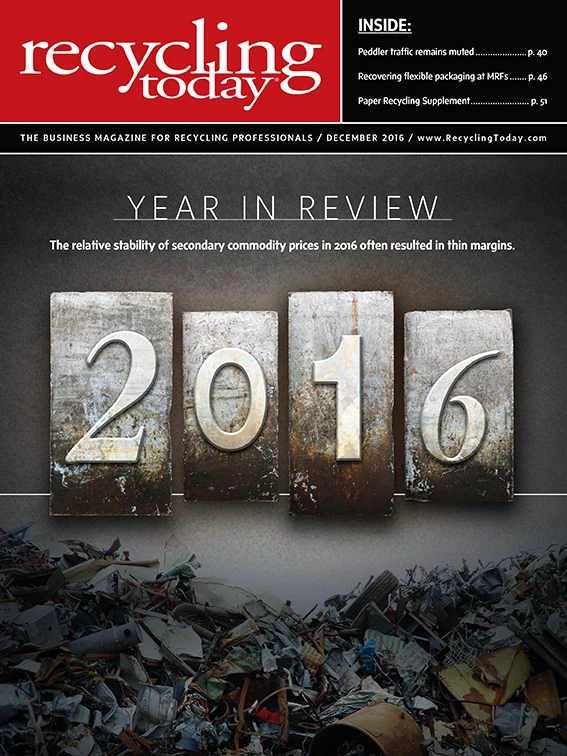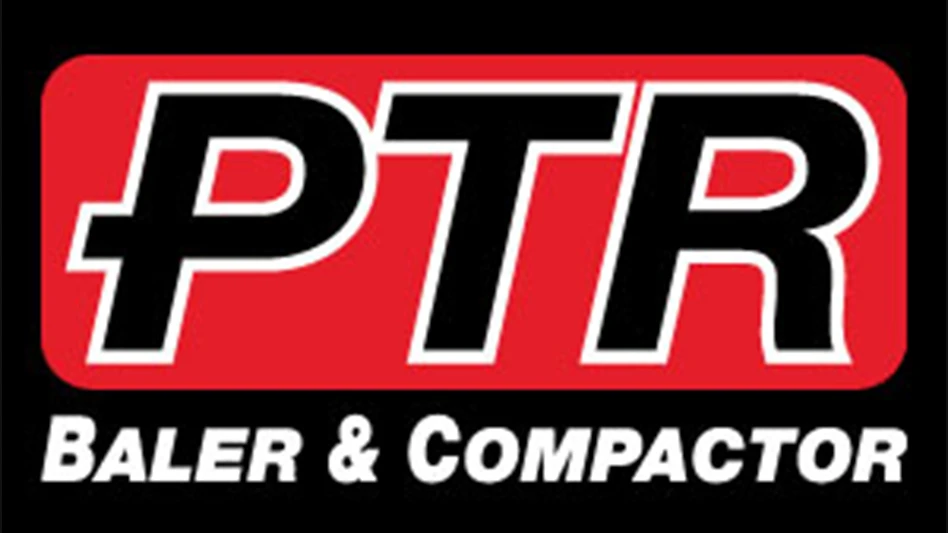
Down. This single word is the answer to the question, “How does rail traffic in 2016 compare with rail traffic in 2015?”
As shown in the chart on page 98 provided by the Association of American Railroads (AAR), Washington, the volumes transported by rail through October 2016 are lower than they were for 2015. In fact, every statistic shows less volume handled in 2016 than in 2015. Coal traffic declined by 40 percent in 2016 compared with 2011 (and by 46.4 percent relative to the peak coal year of 2008), and that decline affects all other statistics that include coal. U.S. carloads excluding coal and intermodal only show a 2 percent decline from 2015.
According to the AAR, the 2016 carload count for scrap iron or steel was down 4.9 percent year to date through October compared with 2015. Shipments of primary metals were down 7.7 percent year to date and metallic ores were down 13.8 percent. However, total carloads of waste and nonferrous scrap actually increased 16.9 percent, though the AAR report indicates that most of that increase was in the form of fly ash from power plants.
Can the rail industry turn this around, and if so, what triggers could stop these declines in 2017 and beyond? What arenas could change the game?
Let’s take a look at just a few to consider.
Political
The recent elections have the potential to create a significant change in the federal government. Not only is the president-elect a businessman who never has been elected to or been appointed to any political office, he is bringing an approach and ideas to the White House that could revolutionize how Washington works. At least that is his claim and the platform on which he ran. With the Republican party also controlling both houses of Congress, the onus falls fully on that party to perform. Consider a few of President-elect Donald J. Trump’s key campaign promises:
- eliminate or roll back many if not all of the federal regulations previously enacted by President Obama – As one Class I railroad executive recently stated to a customer group, “I’m not saying coal is coming back, but ... ,” implying the coal industry likely will improve considerably. Natural gas, power generation and other markets also could be affected. This is the tip of the potential iceberg that could increase production and shipping from various markets. The ripple effect also could impact railcars in storage, railcar manufacturing, railcar leasing, the production of additional rail track and more.
- repeal and replace the Affordable Care Act (ACA or “Obamacare”) – Whether the ACA is fully repealed and replaced or modified to retain certain features acceptable to lawmakers and the new president, we should expect changes in health care—potentially significant changes. Costs for health care could be better contained and access improved, with more value available to employees and more income, corporately and individually, available for other economic choices.
- initiate a stimulus package – President Obama did get a stimulus package, but contrary to what many thought would happen, it didn’t seem to be focused on rebuilding infrastructure, which would have had long-term economic benefits and would have paved the way for economic growth. Instead, it focused on getting cash into the hands of needy families for immediate help. The Trump stimulus is purported to be focused on infrastructure, which in the immediate would, per the Trump campaign, jump-start the economy and provide that long-term benefit.
These potential political changes could have a quick and significant impact on the economy if done correctly. The railroads, if positioned properly with the right resources, stand to benefit as much as anyone. Time will tell.
Regulation
The single largest threat perceived by the railroad industry for economic regulation is “open access” or “competitive switching.” For the past several years, the Surface Transportation Board has had a rulemaking under Ex Parte No. 711 to consider whether a good case exists to modify current rules allowing rail carriers to close a rail shipper to reciprocal switching. When more than one carrier operates within the same switching district and the shipper is physically served by only one of the available carriers, a shipper that is open to reciprocal switching has the option to route its shipments via the other carrier(s) available. The serving carrier switches the car within the switching district to the primary carrier in the route for a switch fee. This grants the shipper competitive access to all available carriers, increasing route options and the competitive pricing that results. Shippers that are closed to this option have no choice but to route with the one serving carrier even if others are physically located within that same switching district. Also known as “captive” shippers, they have no other competitive rail route options and no competitive rail pricing options.

This is a complicated issue where carriers allege any requirement to force open access will reduce or eliminate their ability to invest in working with shippers to build in rail access or to increase capacity and ultimately will increase pricing for everyone. Shippers that support open access obviously believe the more competition the better overall for the economy and for them. If this ever gets traction, it could be a significant issue, though the new GOP coming into power could be averse to more regulation.
Positive train control
In 2008 the U.S. Congress passed a new mandate requiring American railroads to fully implement positive train control (PTC) by the end of 2015. PTC is presented as a solution to prevent human error that results in accidents and death by automatically stopping a train under conditions that otherwise could result in an accident. Everyone wants to achieve that goal, but there were, and still are, several issues with PTC:
- The railroads are required to fund 100 percent of this project, including the development of the technology, testing, installation and financing. The railroad industry sees the price tag, in the range of $10 billion, as unreasonable without government assistance.
- The technology is unproven, and many contend it would only cover a small percentage of the potential rail lines at risk. Therefore, at best, even if 100 percent efficient, some areas may remain unprotected.
- While seven years seemed like plenty of time to lawmakers, it became impossible to complete such a project by the deadline. An extension through 2018 was passed in 2015.
- Training for proper use of the system is only possible once it is fully operational. Even after it is completed, more than 100,000 rail employees have to be trained to use it.
Crew size
When I started working for the railroad more than 42 years ago, we still had a crew of five—conductor, switchman, brakeman, engineer and fireman—on every train. Today all crews on mainline train operations have at least two members, but with PTC and other technology it is theoretically possible to reduce this number to one. Rail carriers contend there is no evidence of higher accident rates with one member compared with more. Labor unions and even the Federal Railroad Administration disagree and suggest a legal minimum requirement of two should apply to all crews operating on mainline tracks. Ironically, in no small part it is the PTC the carriers complain about that could help pave the way for one-person crews.
The economic incentive and benefit of smaller crews is obvious. If crews could be virtually cut in half, the savings would be tremendous.
Rail carriers also point to the trucking industry, its primary competition, which already is testing driverless trucks. If trucks can operate with zero drivers, why can’t locomotives operate with one?
Uncertain future
2016 has been a tough year for the rail industry. The railroads’ success and failure is dependent on the overall economy, especially the health of the industrial sector, but other factors could change the game. The new political landscape under President-elect Trump and the GOP controlling both houses of Congress, the potential rollback of economic regulations, the ongoing implementation of PTC and the potential for a change in crew size all could have significant impact on the immediate and long-term future of the railroads.

Explore the December 2016 Issue
Check out more from this issue and find your next story to read.
Latest from Recycling Today
- Recyclers likely to feel effects of US-China trade war
- BCMRC 2025 session preview: Navigating battery recycling legislation and regulations
- Yanmar Compact Equipment North America appoints new president
- LYB publishes 2024 sustainability report
- Plum Creek Environmental acquires Custom Installation LLC
- Avis introduces Harris American Co.
- International Paper in talks to divest 5 European box plants
- Recycled PP from Polykemi, Rondo Plast used in flood protection product





